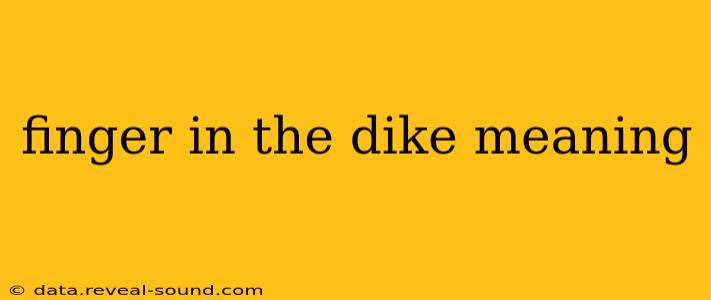The idiom "finger in the dike" (or sometimes "finger in the dam") vividly portrays a desperate, last-ditch effort to prevent a catastrophic disaster. It conjures an image of someone bravely, perhaps even foolishly, trying to hold back an overwhelming force with minimal resources. But what does this idiom really mean, and where did it come from? Let's delve into its history and explore its nuanced interpretations.
What Does "Finger in the Dike" Mean?
At its core, "finger in the dike" describes a situation where a small, seemingly insignificant action is taken to prevent a much larger, potentially disastrous problem. The action itself is often insufficient to solve the root cause, but it buys crucial time or provides a temporary solution. It implies a sense of urgency, resourcefulness, and often, a degree of futility. The person taking the action is likely aware of the inadequacy of their efforts but acts nonetheless, driven by a sense of responsibility or a desire to mitigate the damage.
The Origin of the Idiom: A Dutch Legend?
The idiom's origin is often linked to a Dutch legend. While the precise details vary, the common thread is a story of a boy (or sometimes a girl) who uses their finger to plug a hole in a dike, preventing a devastating flood. This heroic act, while perhaps not entirely historically accurate, encapsulates the core meaning of the idiom perfectly.
This story, passed down through generations, highlights the potential consequences of inaction and the importance of even small contributions in a crisis. The image of a single finger bravely battling the immense power of the water resonates deeply, symbolizing the courage and resilience faced with overwhelming odds.
What are some examples of "a finger in the dike"?
Here are a few scenarios that illustrate the idiom's usage:
-
A single programmer working overtime to patch a critical security flaw in a software system before a major launch. The programmer knows that a full-scale fix is necessary, but their immediate action prevents a potentially catastrophic data breach.
-
A small non-profit organization working tirelessly to alleviate poverty in a community. While their efforts might seem insignificant compared to the scale of the problem, they make a tangible difference in the lives of many individuals.
-
A government implementing temporary measures to control inflation. These measures might not fully address the underlying economic problems, but they help to stabilize the economy in the short term.
Is "finger in the dike" always negative?
While often used in contexts implying a degree of futility, the idiom isn't inherently negative. It can also highlight the importance of small actions, individual responsibility, and the power of perseverance even when faced with insurmountable challenges. It's a testament to the human spirit’s capacity for courage and resourcefulness.
Isn't "finger in the dam" the same thing?
While both phrases are used interchangeably, "finger in the dike" is more common and often considered the original. "Dam" is a more general term, while "dike" specifically refers to an embankment designed to control or prevent flooding, making it more appropriate in the context of the original legend.
Frequently Asked Questions about "Finger in the Dike"
What is the difference between a dike and a dam?
A dike is typically an embankment constructed along a river or coastline to prevent flooding. A dam, on the other hand, is a barrier built across a river to control the flow of water for purposes such as irrigation, power generation, or flood control.
Is there any historical evidence supporting the Dutch boy and the dike story?
While there's no definitive historical record proving the existence of a single boy saving a dike with their finger, the legend highlights a cultural reality: the importance of dike maintenance and the constant struggle against the North Sea in the Netherlands.
Can the idiom "finger in the dike" be applied to environmental issues?
Absolutely. The idiom can perfectly describe small-scale actions to combat climate change, like individual efforts in recycling, conservation, or supporting sustainable initiatives. While these acts might seem minuscule compared to the global scale of the problem, they contribute to a larger movement.
The idiom "finger in the dike" is more than just a colorful expression; it's a powerful metaphor reflecting the human condition. It serves as a reminder that even small actions, taken with courage and determination, can sometimes make a difference, even if the ultimate victory remains uncertain.
